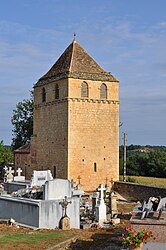Montferrand-du-Périgord
This article's tone or style may not reflect the encyclopedic tone used on Wikipedia. (July 2020) |
Montferrand-du-Périgord | |
|---|---|
 The church in Montferrand-du-Périgord | |
 Coat of arms | |
show Location of Montferrand-du-Périgord | |
 Montferrand-du-Périgord | |
| Coordinates: 44°45′06″N 0°52′01″E / 44.7517°N 0.8669°ECoordinates: 44°45′06″N 0°52′01″E / 44.7517°N 0.8669°E | |
| Country | France |
| Region | Nouvelle-Aquitaine |
| Department | Dordogne |
| Arrondissement | Bergerac |
| Canton | Lalinde |
| Government | |
| • Mayor (2008–2014) | Georges Meyrignac |
| Area 1 | 13.1 km2 (5.1 sq mi) |
| Population (Jan. 2018)[1] | 156 |
| • Density | 12/km2 (31/sq mi) |
| Time zone | UTC+01:00 (CET) |
| • Summer (DST) | UTC+02:00 (CEST) |
| INSEE/Postal code | 24290 /24440 |
| Elevation | 85–234 m (279–768 ft) (avg. 105 m or 344 ft) |
| 1 French Land Register data, which excludes lakes, ponds, glaciers > 1 km2 (0.386 sq mi or 247 acres) and river estuaries. | |
Montferrand-du-Périgord is a commune in the Dordogne department in Nouvelle-Aquitaine in southwestern France.
Population[]
| Year | Pop. | ±% |
|---|---|---|
| 1962 | 232 | — |
| 1968 | 236 | +1.7% |
| 1975 | 211 | −10.6% |
| 1982 | 185 | −12.3% |
| 1990 | 197 | +6.5% |
| 1999 | 180 | −8.6% |
| 2008 | 170 | −5.6% |
The Church of St Christophe – 11th century[]
An exceptional survivor, with remarkable original wall paintings, it is the original village church, and stands within the cemetery up on the hill to the south of the village. It is not clear when or why the village moved away from this site; local, undocumented belief is that it may have been caused by a severe visitation of the plague. It continued to function as the Commune church up to the Revolution of 1847, when the church down in the village was built.
The bell-tower dominates the site. Originally the nave extended as far as the existing arched memorial (moved to this location to record the original length) - about 4 times longer, and also higher than, the remaining fragment (you can see traces of the original roof on the west wall of the tower). Again, there is no record of what happened to the nave, and why it was truncated. The great loss is that the internal plaster paintings went with it - but a rich feast remains.
Externally, on the south wall, is a scratched drawing of the skeleton of a fish, very characteristic of the 11th Century. The Romanesque arch that now seals the nave was built in the 12th Century; and the round apses were added to the basic form later in the century. Further window openings were made at this time; but the 3 small windows in the centre of the chancel arch are original.
Medieval wall paintings[]
Look Heavenwards, up to the ceiling, first. The remaining Romanesque vault of the nave represents the Universe, symbolised by the Moon and the Sun (painted with human faces) set in a bed of stars. Above the Chancel, Christ sits in majesty on a throne, giving His blessing, surrounded by the traditional symbols of the four Evangelists. St Mark is represented by a lion; St Matthew by a winged man; St John by an eagle; and St Luke by a bull, painted in fiery red. In the left-hand bay the paintings depict The Annunciation (with the Angel Gabriel kneeling before Mary); and St Christopher, the patron saint of the church, carrying Jesus over a ford, with his staff bursting into flower. Below this scene are triangular, geometric figures, whose symbolism is not understood today. The main painting on the north wall (to the left as you come in) is a 15th century representation of Hell, represented by Leviathan (the sea monster) swallowing the damned - with a woman astride a lion heading towards him (a symbol of lust). On the opposite (south) wall, all that remains of a substantial painting of the Last Supper, with just 2 of the 12 apostles still visible. There are many further detailed images, including St Leonard freeing the prisoners.
See also[]
References[]
- ^ "Populations légales 2018". INSEE. 28 December 2020.
| Wikimedia Commons has media related to Montferrand-du-Périgord. |
- Communes of Dordogne


